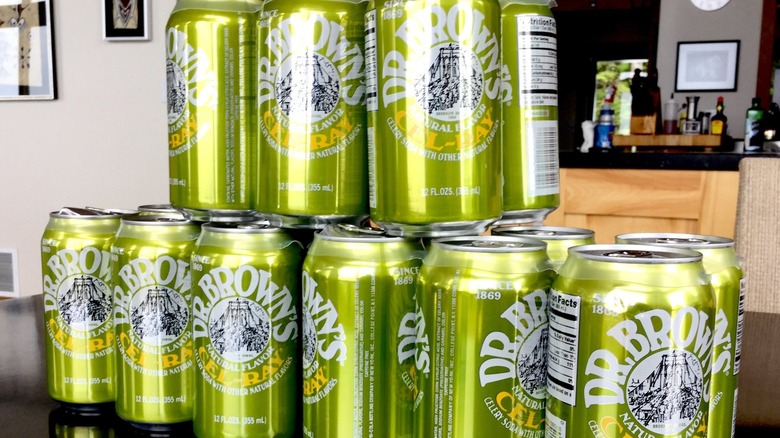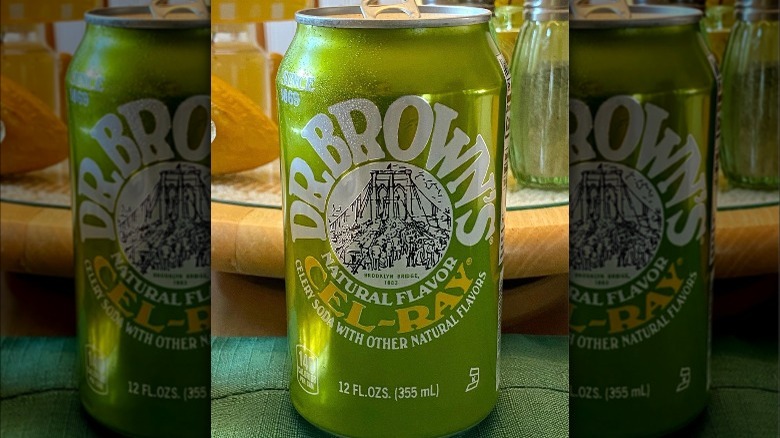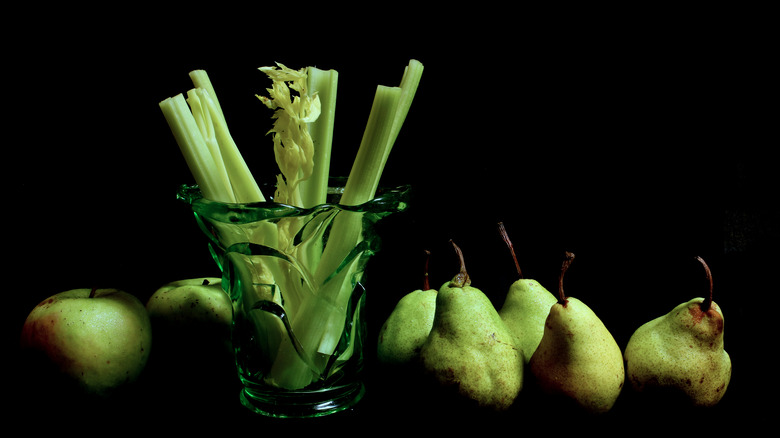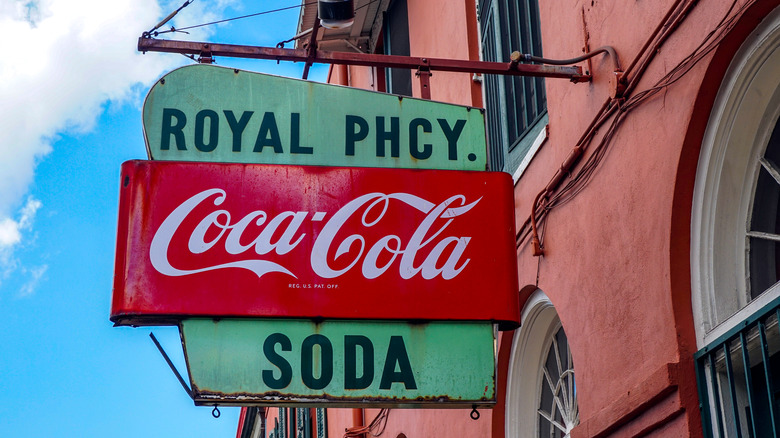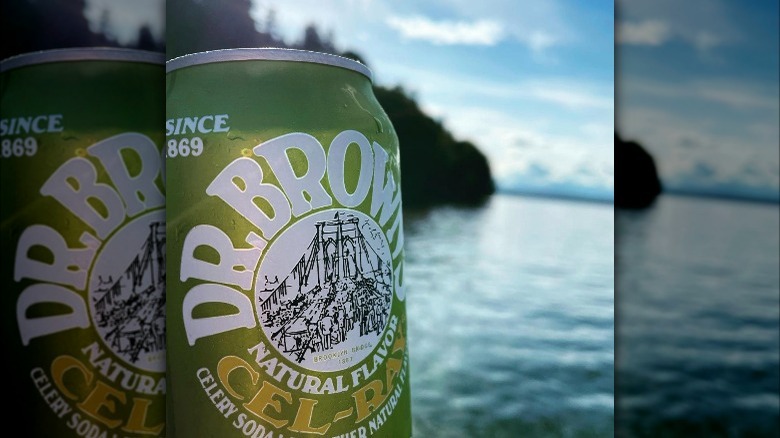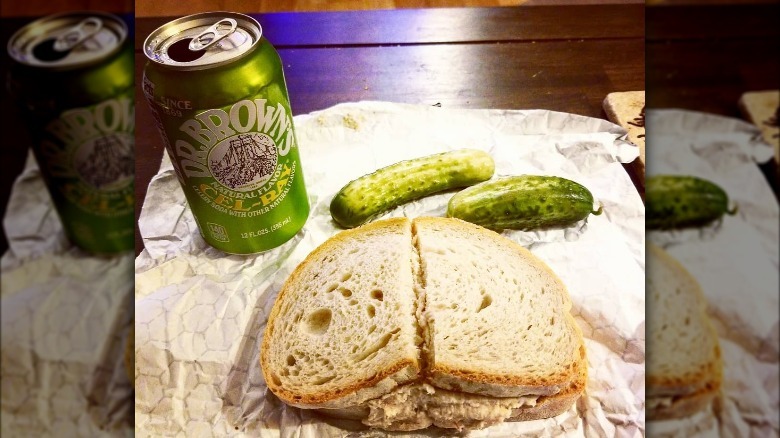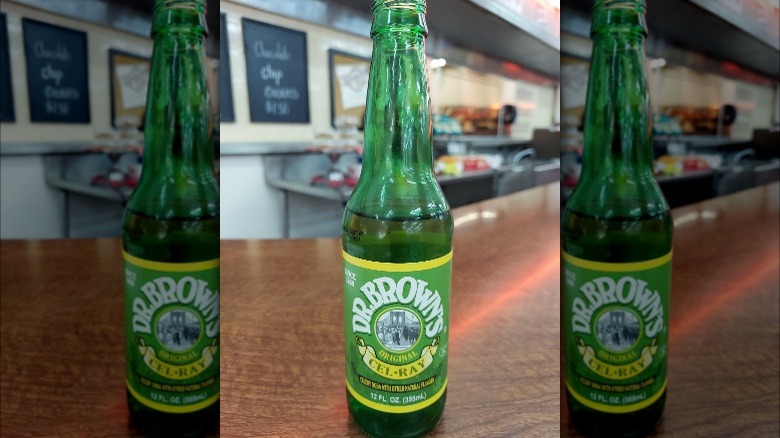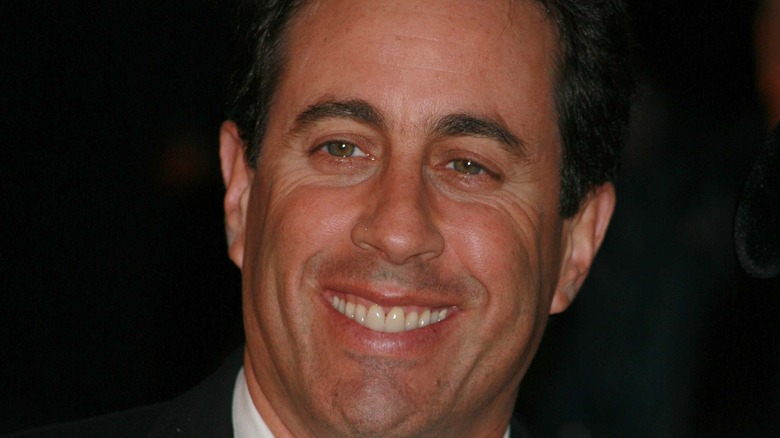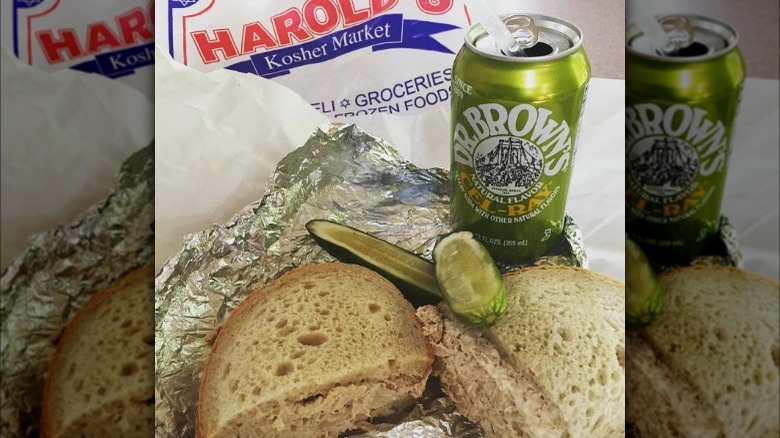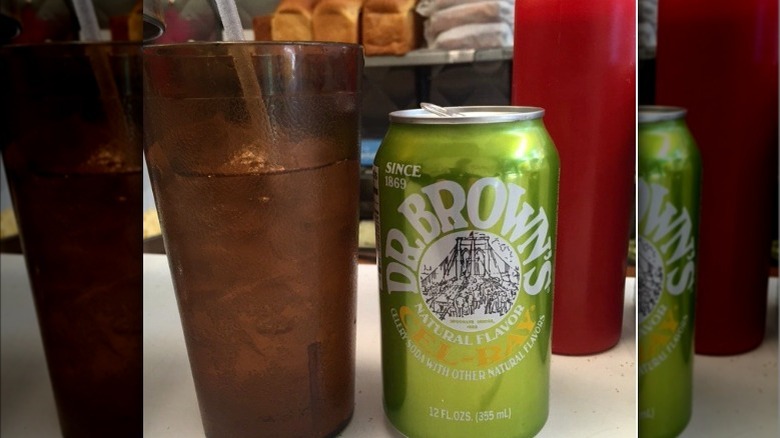The Untold Truth Of Cel-Ray, America's Strangest Soda
As suggested by the name, Dr. Brown's Cel-Ray is a celery-flavored soda. We know, that sounds wild, but trust us: It's actually great, with a crisp, refreshing flavor and only a hint of celery essence. It's been a New York City staple for over a century, becoming a fixture in Jewish delis across the East Coast, according to My Jewish Learning.
However, Cel-Ray is more than just a nostalgic treat for people who grew up going to delis. In its history, it's crossed paths with food trends, quack medical claims, and even a crackdown by the federal government. While Cel-Ray was born from a fad that also birthed several other celery sodas, it was the only one with the staying power to remain in production into the 21st century. Even if you've never had Cel-Ray before, its story might intrigue you. After finding out the untold truth of Cel-Ray, you may even feel inspired to track some down to try for yourself.
Dr. Brown may not have been a real person
Every can of Cel-Ray proudly proclaims that it's been produced since 1869, a fact which the Los Angeles Times noted would make it older than other, more famous New York icons like the Brooklyn Bridge and the Statue of Liberty. However, that claim hinges on the existence of a Dr. Brown who invented recipes for celery tonic and cream soda at that time, and there's no hard evidence that he was a real person. As Dr. Brown's marketing director Harry Gold told the Los Angeles Times in 1986, "We have no records that tell us anything about the good doctor. It's like a biblical story. We accept it on faith."
The Jewish Star recounted one version of the Dr. Brown's myth, in which the mythical doctor was a physician in Manhattan's Lower East Side who invented a tonic made with celery seeds and sugar. Allegedly, it was originally intended to improve the health of immigrant kids in the Lower East Side and Williamsburg Brooklyn. Dr. Brown then supposedly lent his recipe to a friend who worked at a bottling plant, who turned it into a bottled soft drink.
While this origin story is fun, all records indicate that the Dr. Brown's brand began its life as a product of the Schoneberger & Noble company, which began manufacturing Cel-Ray and cream soda in 1886. If a real celery tonic-inventing Dr. Brown did exist, he has been lost to history.
At the time Cel-Ray was created, America was in the middle of a celery craze
Celery is a pretty commonplace vegetable today. It's ubiquitous, but little-remarked on. While we use it for snacks, crudites, and in mirepoix, it's not a buzzy hot-ticket item, and you don't really see celery-flavored foods or beverages very often. You might think, "How and why would anyone think to make a celery soda?"
When Cel-Ray was invented in the 19th century, celery was the most stylish vegetable you could buy, and possessing celery was a prerequisite for being seen as having sophisticated taste or social clout. Taste likens celery's place in Victorian-era culture to avocado toast's domination of the early 21st century. Like avocado toast, celery was a status symbol and an indication of wealth. Throughout most of the 19th century, celery was expensive and difficult to grow, which of course made the upper classes desire it as a luxury item. It was so highly prized that households displayed it in specially-crafted celery vases. America was wild for anything celery-related in the 1800s, so it's no wonder that celery soda came about at this time.
Like many sodas, it was marketed as a health tonic
MyRecipes writes that in the 19th century, sodas were marketed as medicines and sold in pharmacies. Dr. Brown's isn't the only soda from the era with an apocryphal doctor's name behind it: We're looking at you, Dr. Pepper. Speaking of Dr. Pepper, it originally contained the psychiatric drug lithium, according to Serious Eats. Coca-Cola, which was sold as a "nerve tonic," infamously used cocaine in its initial formula.
Dr. Brown's insider Marianne Santora told Serious Eats that the company's original celery tonic "was thought to be good for calming stomachs and bowels." This health claim was echoed in a Cel-Ray ad from 1910 that said the soda "strengthens the appetite and aids digestion" (via The Jewish Star). That ad also cribbed from Coca-Cola's marketing by saying that Cel-Ray was "a pure beverage for the nerves," whatever that means. It seems that whatever ailed you in the late 19th and early 20th centuries, it could be fixed by some kind of medicinal soda.
The government had to crack down on celery soda's medicinal claims
Of course, soda is not medicine, and Cel-Ray probably can't actually cure anything except thirst. The soda's medicinal claims were bolstered by celery's perception as a superfood (via Serious Eats). Celery has been used in traditional medicine in a variety of cultures for thousands of years, and in the 19th century, it had a reputation as something of a cure-all. Although Cel-Ray is flavored with celery seeds rather than the vegetable celery, it still benefited from celery's health halo.
According to MyRecipes, the turn of the 20th century saw a profusion of celery sodas that advertised themselves using bogus medical claims. Many of Cel-Ray's competitors contained narcotics like cocaine in addition to caffeine and celery extract. The American government decided to step in, passing the Pure Food and Drug Act in 1906 to try to enforce purity standards and truth in advertising. This, combined with the end of the celery fad and the outlawing of cocaine in 1922, killed off most of the celery sodas on the market. Dr. Bown's survived, but the Food and Drug Administration did make it change its name. Until the mid-20th century, Cel-Ray was known as "Dr. Brown's Celery Tonic," a name that makes it sound a whole lot more like medicine than soda.
For much of its history, Cel-Ray was only available at Jewish delis
Although you can find Cel-Ray in cities across the U.S. these days, it wasn't always so widely available. For most of the 20th century, you could only find the soda in Jewish delis in the New York area. Harry Gold, who at the time was the director of franchise development for Dr. Brown's, told The New York Times in 1984 that ”We enjoyed a tremendous loyalty from the delis in New York that we first started selling to 60 to 70 years ago ... We reciprocated that loyalty by not making the product available anywhere else."
While that strategy proved effective for a long time, by the 1980s, Jewish deli culture in New York was declining. Seeing the writing on the wall, Dr. Brown's expanded its reach beyond the New York delicatessen market. It did so in baby steps, first by selling its soda to Jewish delis in other major metropolitan areas, and then making the leap to grocery stores. The move paid dividends, and Dr. Brown's sales increased during the early 1980s.
It's been owned by many companies over the years
Dr. Brown's has a complicated corporate history. If we are to believe the legend, it was first owned by the eponymous Dr. Brown. We know for sure that Schoneberger and Noble owned it by the late 1800s. Then, in 1928, that company combined with two other soft drink manufacturers, creating The American Beverage Corporation (via The Jewish Star). The American Beverage Corp. era coincided with Cel-Ray's run as a fixture in New York's deli scene. Per The New York Times, Canada Dry Bottling of New York, a subsidiary of the famous ginger ale maker, bought Dr. Brown's in 1982. It was under Canada Dry's leadership that Cel-Ray became more widely available.
These days, the rights to the Cel-Ray brand are split between two companies. The Jewish Star says that Canada Dry, which is now a subsidiary of Pepsi, still makes the soda on the East Coast. They produce all the Dr. Brown's in aluminum cans. Southern California's J&R Bottling company makes Dr. Brown's on the West Coast, packaging it exclusively in glass bottles. If you're worried you might get a different product depending on which company makes it, don't fret: It's the same soda regardless of whether it's in a bottle or a can.
Cel-Ray has received shoutouts from Seinfeld and Frank Zappa
Cel-Ray is a little-known niche beverage, but it's been referenced fairly frequently in popular media. Perhaps it benefits from its status as a New York City icon in that regard. Another New York icon, Jerry Seinfeld, incorporated probably the most noteworthy Cel-Ray reference into the "Seinfeld" episode "The Pothole" (via My Jewish Learning). Jerry, unable to kiss his girlfriend, uses the soda as an excuse, saying "I bruised my lip; I was drinking a Cel-Ray and I brought it up too fast."
According to The Jewish Star, Cel-Ray also appears in the New York-set film "Serpico," and James Caan drinks it on-screen when playing the real-life composer, showman, and New Yorker Billy Rose in the film "Funny Lady." Although he didn't grow up in New York, Frank Zappa also shouts out Cel-Ray in his 1971 live album "Fillmore East — June 1971." Not bad for a little soda brand that barely expanded beyond one city for its first century of existence!
Cel-Ray is connected to Eastern European and Jewish food traditions
Cel-Ray has long had a special association with Jewish culture. The affinity for Cel-Ray in the community is so strong that the soda's nickname is Jewish Champaign (via Vice). It's the perfect palate cleanser for a meal at a Jewish deli, with the slightly astringent celery seed taste cutting through the fatty cured meats and heavy starches. Its connection to Jewish foodways stretches back even farther than the deli, however. David Sax, author of "The Tastemakers," told Serious Eats that the soda industry employed many Eastern European Jewish immigrants in New York City. Sax suggests that these immigrants' previous history as beet sugar farmers in their home countries made them a perfect fit for the sugar-heavy soda business.
Additionally, celery is a traditional flavor in Eastern European cuisine, and the region has many traditional savory carbonated beverages. If you grew up drinking something like fermented lettuce kvass, the idea of putting savory flavors like celery into a soda probably wouldn't seem so strange.
Delis sent care packages with Dr. Brown's to Jewish residents of Flint during the water crisis
We're not kidding: Dr. Brown's runs deep in the Jewish community. According to the Jewish Standard, in 2016, Jewish organizations banded together to assist Jewish residents of Flint, Michigan, who were struggling to deal with the effects of the city's water crisis. Although Flint's Jewish community was small, numbering 66 households at the time, they needed the help; a high percentage of them were elderly, making leaving the house to access emergency rations a challenge.
Help came in many forms. Congregations in Detroit sent money and organized bottled water delivery. A Flint transplant in San Francisco sent local favorites like Vernors ginger ale and Koegel's hot dogs. Most pertinent to us, however, was the contribution from Shapiro's, a deli in Indianapolis. They donated a Shabbat feast consisting of matzo ball soup, deli meats, knishes, and, to wash it all down, Dr. Brown's.
Not everyone is a fan
Although Dr. Brown's really doesn't taste particularly strange (think of it as an alternative to ginger ale or 7UP with a mildly bitter vegetal note), there's no pleasing everyone, and some people definitely think it's gross. You either love it or you hate it; according to The New York Times, it's "a divisive drink, with ardent fans and staunch detractors." Grub Street founder Josh Ozersky described his hatred for Cel-Ray incredibly vividly, saying, "Cel-Ray is a nasty, bilious tonic forced upon this generation by the Jewish martyr complexes of the prior one. They grew up eating the bitter herbs that reminded them of slavery and they thought that people should eat bad things as a penance for our crimes" (via Vice).
Even some people who sell Cel-Ray aren't big on the flavor. Serious Eats quotes soda store owner Taylor Peck as saying, "I don't pick up a Cel-Ray and say, 'wow, that is amazing.' I say, 'that is a carbonated celery drink.' It is what it says it is." Despite not loving the taste himself, Peck admires Cel-Ray for its longevity, and for carrying the torch for left-field soda ingredients.
